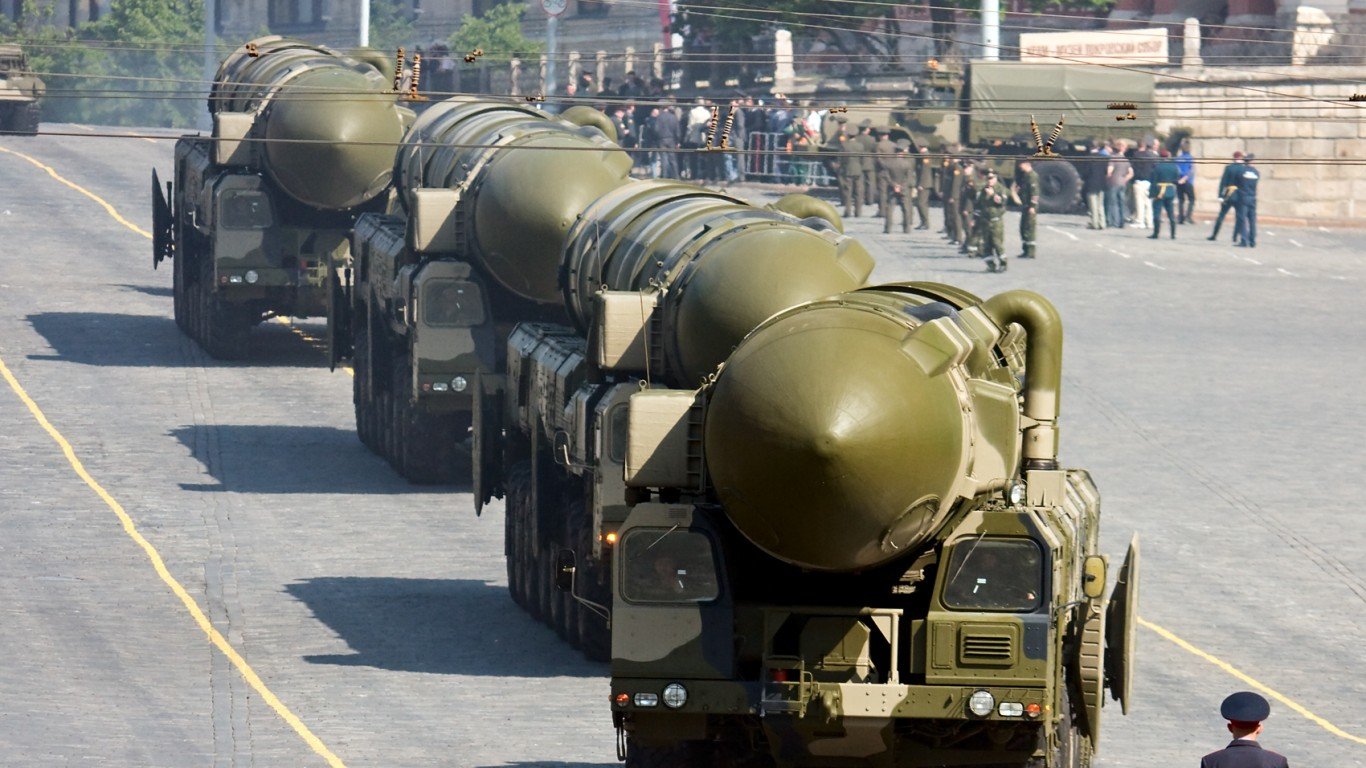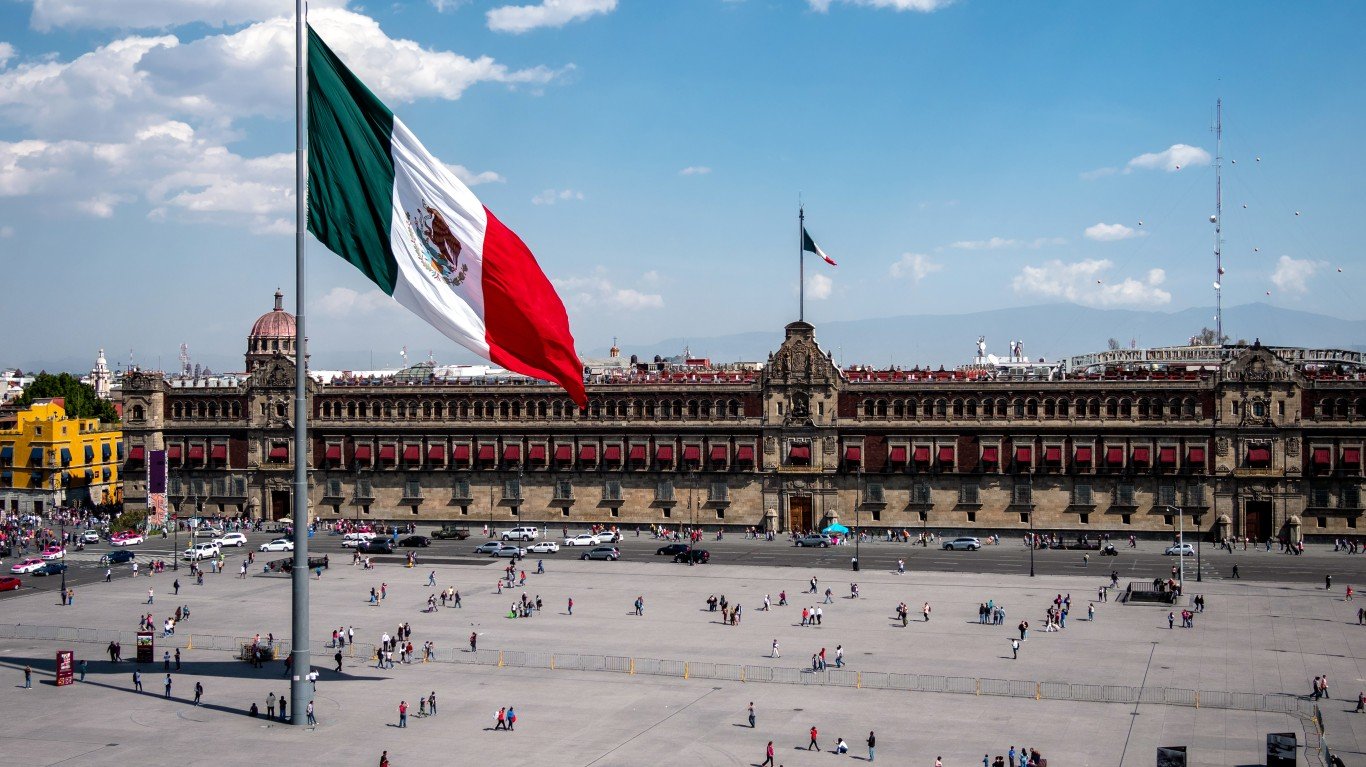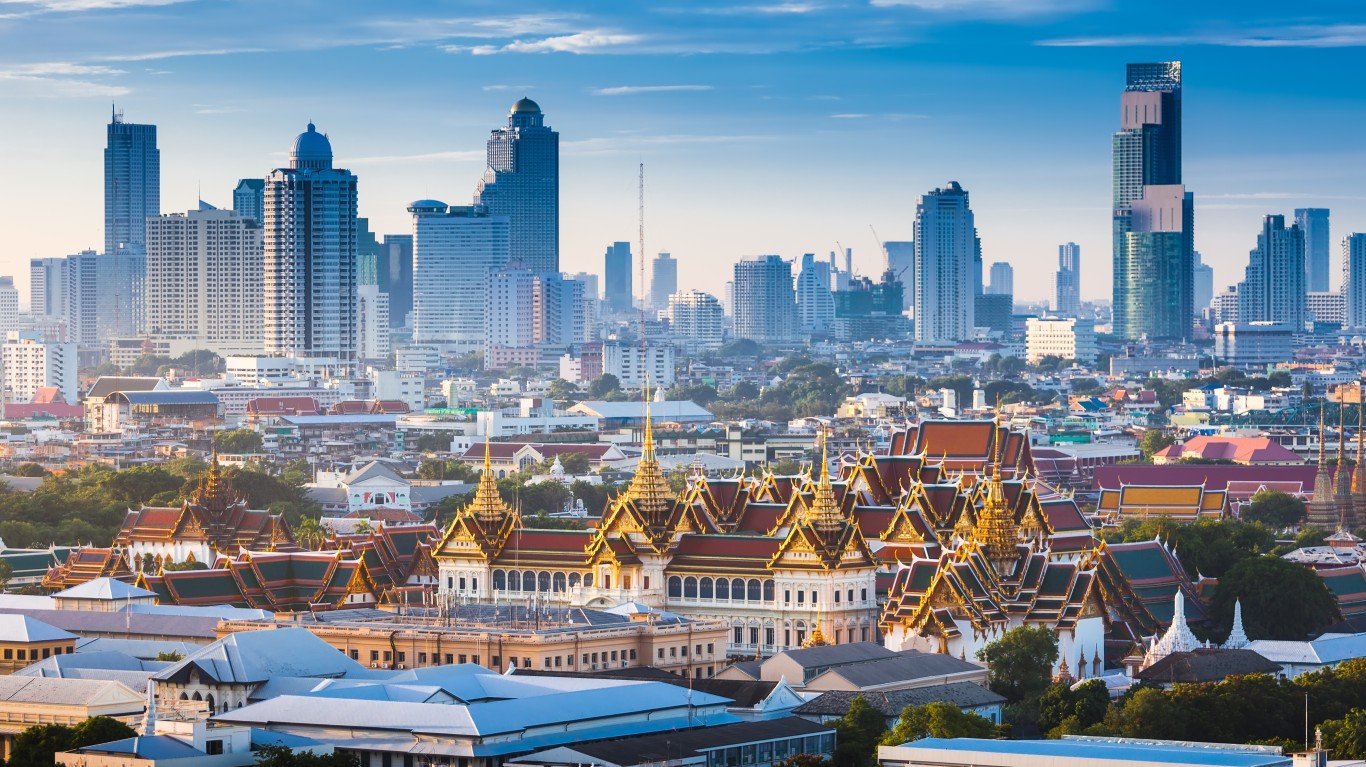

With the deployment of Russian nuclear weapons near Ukraine and an elevated defiant stance against North Korea by the United States on the Korean Peninsula using a nuclear-armed submarine, people on the streets across the world seem more concerned than usual about the possibility that a nuclear, chemical, or biological weapon would soon be used somewhere in the world, according to the latest annual survey conducted in 2022 by global market research firm Ipsos.
To find the countries where people are most afraid of a nuclear, biological or chemical attack, 24/7 Wall St. reviewed a 2022 survey Conducted by Ipsos on behalf of the Halifax International Security Forum. Ipsos surveyed over 32,000 adults in 33 countries. One of the questions was: “How real do you feel the threat is of a nuclear, biological or chemical attack taking place somewhere in the world in the next twelve months?” 75% of more than 32,000 adult respondents spread across 33 countries considered the threat to be “very/somewhat” real. This is a nine-point increase from 2021, and higher than 2017 when North Korea conducted its first nuclear bomb test. We listed the 25 countries where 69% or greater believed it to be a threat.
In nine of these countries, the increase in the number of respondents who believed this WMD threat was very or somewhat real was more than the global average increase of 9 percentage points, led by respondents in France and Germany with a 19-point increase to 63% and 73% of respondents, respectively. Japan is the only non-European country where this increase was greater than the global average. In the United States,77% of respondents expressed the same view, a 6-point rise compared to 2021.
Only about four in ten respondents said they were “very/somewhat” confident in their government’s response to a WMD attack. Italy, Argentina, and Belgium had the smallest share of respondents who had high confidence in the government response to such an attack.
This increase in concern over the possible use of WMDs somewhere in the world in the near future could rise further in 2023 considering the ongoing war in Ukraine and rising tensions in the Korean Peninsula.
In June, President Vladimir Putin said he sent short-range tactical nuclear weapons to neighboring Belarus, putting them well within range of battlefields in Ukraine. Weeks after Putin’s announcement, senior Russian official Dmitry Medvedev said Moscow might be forced to use a nuclear weapon if Ukraine’s counteroffensive succeeds. It echoed similar ominous statements from the former Russian president, who last year warned of Russian nuclear expansion should Sweden and Finland join NATO. Helsinki joined NATO in April 2022 and Stockholm is poised to join the military alliance after Turkey dropped its objections in July. In September, Medvedev said strategic nuclear weapons could be used to defend Russian-claimed parts of Ukraine.
Meanwhile, the United States this summer docked the USS Kentucky, a nuclear armed submarine, at the southern port of Busan, South Korea. It was the first such deployment in more than 40 years, part of a new U.S. strategy of periodically parking nuclear-armed subs on the Korean Peninsula to counter aggressive stances by North Korea. Pyongyang responded to the move by launching its 15th suspected intercontinental ballistic missile this year, which landed in waters near Japan.
Here are the countries where people are most concerned about the use of WMDs.
Click here to read our detailed methodology.

25. Malaysia
> Pct who believe a nuclear, chemical, or biological weapons threat is real: 69% (+4 ppt from last year)
> Pct confident in gov’t response to such threat: 53% (+3 ppt from last year)
> Military expenditure, 2022: $3.7 billion (#49 highest of 152 countries)
> Military expenditure as pct of GDP, 2022: 0.96% (#112 highest of 150 countries)
> Population, 2022: 33,573,874
[in-text-ad]

24. Brazil
> Pct who believe a nuclear, chemical, or biological weapons threat is real: 69% (+6 ppt from last year)
> Pct confident in gov’t response to such threat: 40% (+4 ppt from last year)
> Military expenditure, 2022: $20.2 billion (#17 highest of 152 countries)
> Military expenditure as pct of GDP, 2022: 1.05% (#108 highest of 150 countries)
> Population, 2022: 214,326,223

23. Belgium
> Pct who believe a nuclear, chemical, or biological weapons threat is real: 71% (+16 ppt from last year)
> Pct confident in gov’t response to such threat: 29% (+0 ppt from last year)
> Military expenditure, 2022: $6.9 billion (#33 highest of 152 countries)
> Military expenditure as pct of GDP, 2022: 1.18% (#96 highest of 150 countries)
> Population, 2022: 11,592,952

22. Netherlands
> Pct who believe a nuclear, chemical, or biological weapons threat is real: 72% (+16 ppt from last year)
> Pct confident in gov’t response to such threat: 42% (-5 ppt from last year)
> Military expenditure, 2022: $15.6 billion (#19 highest of 152 countries)
> Military expenditure as pct of GDP, 2022: 1.58% (#66 highest of 150 countries)
> Population, 2022: 17,533,044
[in-text-ad-2]

21. Poland
> Pct who believe a nuclear, chemical, or biological weapons threat is real: 72% (+15 ppt from last year)
> Pct confident in gov’t response to such threat: 44% (+12 ppt from last year)
> Military expenditure, 2022: $16.6 billion (#18 highest of 152 countries)
> Military expenditure as pct of GDP, 2022: 2.39% (#33 highest of 150 countries)
> Population, 2022: 37,747,124

20. India
> Pct who believe a nuclear, chemical, or biological weapons threat is real: 72% (-3 ppt from last year)
> Pct confident in gov’t response to such threat: 69% (+1 ppt from last year)
> Military expenditure, 2022: $81.4 billion (#4 highest of 152 countries)
> Military expenditure as pct of GDP, 2022: 2.43% (#32 highest of 150 countries)
> Population, 2022: 1,407,563,842
[in-text-ad]

19. Hungary
> Pct who believe a nuclear, chemical, or biological weapons threat is real: 73% (+8 ppt from last year)
> Pct confident in gov’t response to such threat: 44% (+1 ppt from last year)
> Military expenditure, 2022: $2.6 billion (#58 highest of 152 countries)
> Military expenditure as pct of GDP, 2022: 1.53% (#69 highest of 150 countries)
> Population, 2022: 9,709,891

18. Canada
> Pct who believe a nuclear, chemical, or biological weapons threat is real: 73% (+9 ppt from last year)
> Pct confident in gov’t response to such threat: 42% (-2 ppt from last year)
> Military expenditure, 2022: $26.9 billion (#14 highest of 152 countries)
> Military expenditure as pct of GDP, 2022: 1.24% (#91 highest of 150 countries)
> Population, 2022: 38,226,498

17. Argentina
> Pct who believe a nuclear, chemical, or biological weapons threat is real: 73% (-1 ppt from last year)
> Pct confident in gov’t response to such threat: 33% (-4 ppt from last year)
> Military expenditure, 2022: $2.6 billion (#57 highest of 152 countries)
> Military expenditure as pct of GDP, 2022: 0.41% (#143 highest of 150 countries)
> Population, 2022: 45,808,747
[in-text-ad-2]

16. Germany
> Pct who believe a nuclear, chemical, or biological weapons threat is real: 73% (+19 ppt from last year)
> Pct confident in gov’t response to such threat: 42% (+2 ppt from last year)
> Military expenditure, 2022: $55.8 billion (#7 highest of 152 countries)
> Military expenditure as pct of GDP, 2022: 1.39% (#81 highest of 150 countries)
> Population, 2022: 83,196,078

15. Sweden
> Pct who believe a nuclear, chemical, or biological weapons threat is real: 75% (+10 ppt from last year)
> Pct confident in gov’t response to such threat: 57% (+7 ppt from last year)
> Military expenditure, 2022: $7.7 billion (#32 highest of 152 countries)
> Military expenditure as pct of GDP, 2022: 1.31% (#88 highest of 150 countries)
> Population, 2022: 10,415,811
[in-text-ad]

14. Spain
> Pct who believe a nuclear, chemical, or biological weapons threat is real: 76% (+6 ppt from last year)
> Pct confident in gov’t response to such threat: 41% (-7 ppt from last year)
> Military expenditure, 2022: $20.3 billion (#16 highest of 152 countries)
> Military expenditure as pct of GDP, 2022: 1.47% (#75 highest of 150 countries)
> Population, 2022: 47,415,750

13. Romania
> Pct who believe a nuclear, chemical, or biological weapons threat is real: 77% (+n/a ppt from last year)
> Pct confident in gov’t response to such threat: 42% (+n/a ppt from last year)
> Military expenditure, 2022: $5.2 billion (#40 highest of 152 countries)
> Military expenditure as pct of GDP, 2022: 1.73% (#52 highest of 150 countries)
> Population, 2022: 19,119,880

12. Chile
> Pct who believe a nuclear, chemical, or biological weapons threat is real: 77% (+2 ppt from last year)
> Pct confident in gov’t response to such threat: 40% (-7 ppt from last year)
> Military expenditure, 2022: $5.6 billion (#38 highest of 152 countries)
> Military expenditure as pct of GDP, 2022: 1.83% (#49 highest of 150 countries)
> Population, 2022: 19,493,184
[in-text-ad-2]

11. United Kingdom
> Pct who believe a nuclear, chemical, or biological weapons threat is real: 77% (+15 ppt from last year)
> Pct confident in gov’t response to such threat: 49% (+7 ppt from last year)
> Military expenditure, 2022: $68.5 billion (#6 highest of 152 countries)
> Military expenditure as pct of GDP, 2022: 2.23% (#37 highest of 150 countries)
> Population, 2022: 67,026,300

10. United States
> Pct who believe a nuclear, chemical, or biological weapons threat is real: 77% (+6 ppt from last year)
> Pct confident in gov’t response to such threat: 50% (+4 ppt from last year)
> Military expenditure, 2022: $876.9 billion (#1 highest of 152 countries)
> Military expenditure as pct of GDP, 2022: 3.45% (#15 highest of 150 countries)
> Population, 2022: 332,031,554
[in-text-ad]

9. Ireland
> Pct who believe a nuclear, chemical, or biological weapons threat is real: 78% (+n/a ppt from last year)
> Pct confident in gov’t response to such threat: 39% (+n/a ppt from last year)
> Military expenditure, 2022: $1.2 billion (#71 highest of 152 countries)
> Military expenditure as pct of GDP, 2022: 0.23% (#147 highest of 150 countries)
> Population, 2022: 5,033,165

8. Australia
> Pct who believe a nuclear, chemical, or biological weapons threat is real: 78% (+6 ppt from last year)
> Pct confident in gov’t response to such threat: 47% (-1 ppt from last year)
> Military expenditure, 2022: $32.3 billion (#13 highest of 152 countries)
> Military expenditure as pct of GDP, 2022: 1.90% (#47 highest of 150 countries)
> Population, 2022: 25,688,079

7. Mexico
> Pct who believe a nuclear, chemical, or biological weapons threat is real: 78% (+2 ppt from last year)
> Pct confident in gov’t response to such threat: 42% (-1 ppt from last year)
> Military expenditure, 2022: $8.5 billion (#28 highest of 152 countries)
> Military expenditure as pct of GDP, 2022: 0.61% (#131 highest of 150 countries)
> Population, 2022: 126,705,138
[in-text-ad-2]
6. Colombia
> Pct who believe a nuclear, chemical, or biological weapons threat is real: 79% (-1 ppt from last year)
> Pct confident in gov’t response to such threat: 41% (-1 ppt from last year)
> Military expenditure, 2022: $9.9 billion (#25 highest of 152 countries)
> Military expenditure as pct of GDP, 2022: 3.08% (#18 highest of 150 countries)
> Population, 2022: 51,516,562

5. Peru
> Pct who believe a nuclear, chemical, or biological weapons threat is real: 80% (+5 ppt from last year)
> Pct confident in gov’t response to such threat: 35% (-7 ppt from last year)
> Military expenditure, 2022: $2.8 billion (#55 highest of 152 countries)
> Military expenditure as pct of GDP, 2022: 1.15% (#99 highest of 150 countries)
> Population, 2022: 33,715,471
[in-text-ad]
4. South Africa
> Pct who believe a nuclear, chemical, or biological weapons threat is real: 81% (+7 ppt from last year)
> Pct confident in gov’t response to such threat: 35% (-3 ppt from last year)
> Military expenditure, 2022: $3.0 billion (#53 highest of 152 countries)
> Military expenditure as pct of GDP, 2022: 0.74% (#121 highest of 150 countries)
> Population, 2022: 59,392,255

3. Japan
> Pct who believe a nuclear, chemical, or biological weapons threat is real: 81% (+17 ppt from last year)
> Pct confident in gov’t response to such threat: 56% (+12 ppt from last year)
> Military expenditure, 2022: $46.0 billion (#10 highest of 152 countries)
> Military expenditure as pct of GDP, 2022: 1.08% (#106 highest of 150 countries)
> Population, 2022: 125,681,593

2. Türkiye
> Pct who believe a nuclear, chemical, or biological weapons threat is real: 82% (-3 ppt from last year)
> Pct confident in gov’t response to such threat: 53% (+3 ppt from last year)
> Military expenditure, 2022: $10.6 billion (#23 highest of 152 countries)
> Military expenditure as pct of GDP, 2022: 1.23% (#92 highest of 150 countries)
> Population, 2022: 84,775,404
[in-text-ad-2]

1. Thailand
> Pct who believe a nuclear, chemical, or biological weapons threat is real: 84% (+n/a ppt from last year)
> Pct confident in gov’t response to such threat: 45% (+n/a ppt from last year)
> Military expenditure, 2022: $5.7 billion (#37 highest of 152 countries)
> Military expenditure as pct of GDP, 2022: 1.16% (#98 highest of 150 countries)
> Population, 2022: 71,601,103
Methodology
To find the countries where people are most afraid of a nuclear, biological or chemical attack, 24/7 Wall St. reviewed a 2022 survey, conducted by global market research firm Ipsos on behalf of the Halifax International Security Forum. Ipsos surveyed over 32,000 adults in 33 countries. One of the questions was: “How real do you feel the threat is of a nuclear, biological or chemical attack taking place somewhere in the world in the next twelve months?” Countries are ordered by the percent of respondents who said it is a very/somewhat a real threat. In the case of ties, countries with larger populations are ranked higher. We listed the 25 countries where 69% or greater believed it to be a threat.
Another question was aimed to gauge the confidence in government response to such a threat: “If a nuclear, biological or chemical attack took place somewhere in the world in the next twelve months, how confident are you that the appropriate levels of security and protection could be provided by your government or its agencies could respond effectively?”
24/7 Wall St. added military spending as a percentage of a country’s gross domestic product and military expenditures in current U.S. dollars, both for 2022, from the Stockholm International Peace Research Institute Military Expenditure Database. 2022 population figures are from the World Bank.
Take This Retirement Quiz To Get Matched With An Advisor Now (Sponsored)
Are you ready for retirement? Planning for retirement can be overwhelming, that’s why it could be a good idea to speak to a fiduciary financial advisor about your goals today.
Start by taking this retirement quiz right here from SmartAsset that will match you with up to 3 financial advisors that serve your area and beyond in 5 minutes. Smart Asset is now matching over 50,000 people a month.
Click here now to get started.
Thank you for reading! Have some feedback for us?
Contact the 24/7 Wall St. editorial team.
 24/7 Wall St.
24/7 Wall St. 24/7 Wall St.
24/7 Wall St. 24/7 Wall St.
24/7 Wall St.

 24/7 Wall St.
24/7 Wall St.